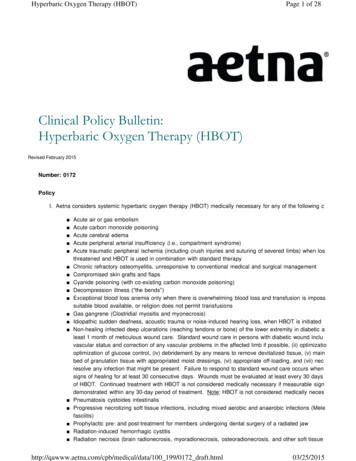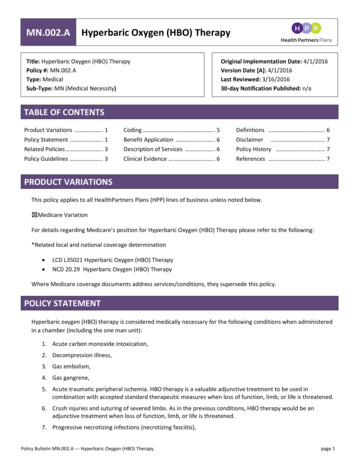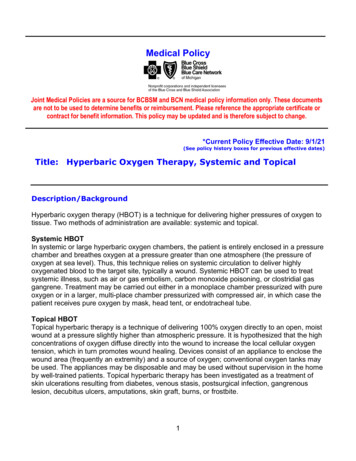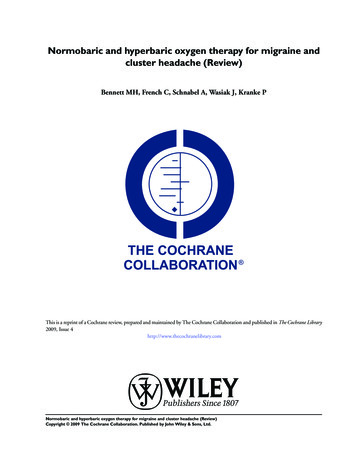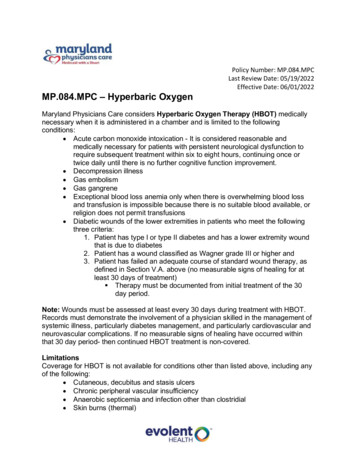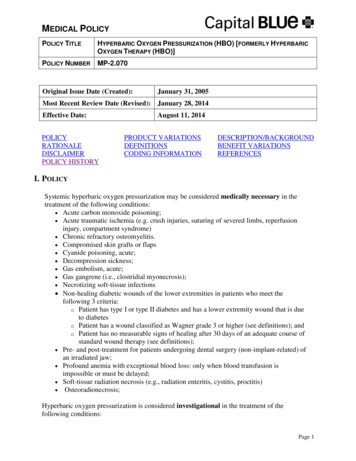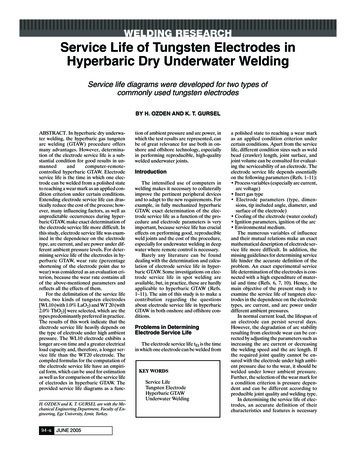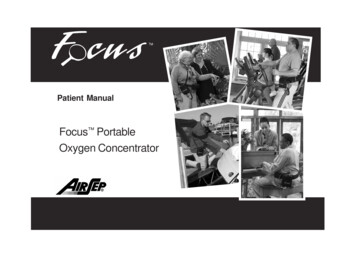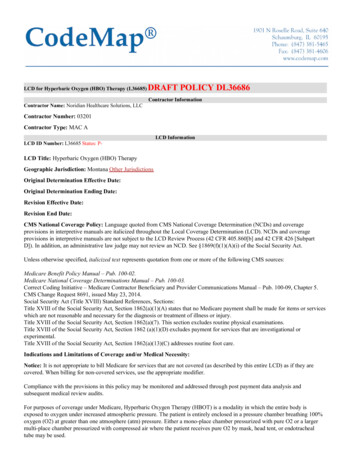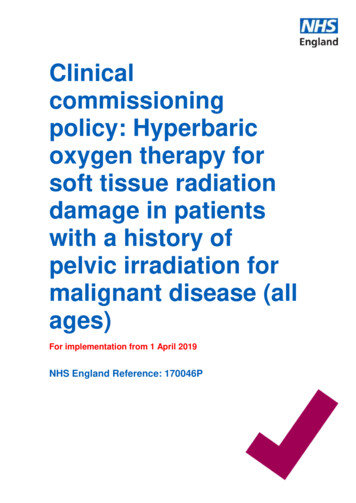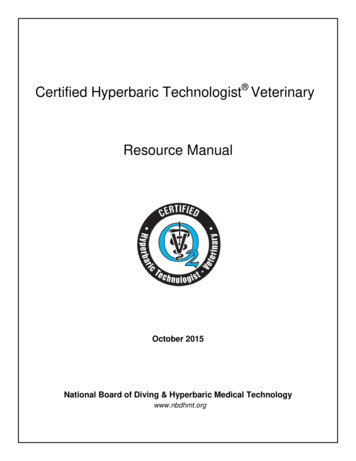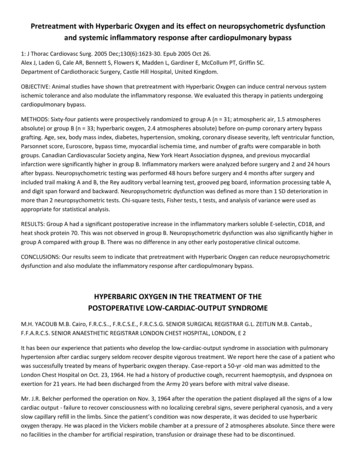
Transcription
Pretreatment with Hyperbaric Oxygen and its effect on neuropsychometric dysfunctionand systemic inflammatory response after cardiopulmonary bypass1: J Thorac Cardiovasc Surg. 2005 Dec;130(6):1623‐30. Epub 2005 Oct 26.Alex J, Laden G, Cale AR, Bennett S, Flowers K, Madden L, Gardiner E, McCollum PT, Griffin SC.Department of Cardiothoracic Surgery, Castle Hill Hospital, United Kingdom.OBJECTIVE: Animal studies have shown that pretreatment with Hyperbaric Oxygen can induce central nervous systemischemic tolerance and also modulate the inflammatory response. We evaluated this therapy in patients undergoingcardiopulmonary bypass.METHODS: Sixty‐four patients were prospectively randomized to group A (n 31; atmospheric air, 1.5 atmospheresabsolute) or group B (n 33; hyperbaric oxygen, 2.4 atmospheres absolute) before on‐pump coronary artery bypassgrafting. Age, sex, body mass index, diabetes, hypertension, smoking, coronary disease severity, left ventricular function,Parsonnet score, Euroscore, bypass time, myocardial ischemia time, and number of grafts were comparable in bothgroups. Canadian Cardiovascular Society angina, New York Heart Association dyspnea, and previous myocardialinfarction were significantly higher in group B. Inflammatory markers were analyzed before surgery and 2 and 24 hoursafter bypass. Neuropsychometric testing was performed 48 hours before surgery and 4 months after surgery andincluded trail making A and B, the Rey auditory verbal learning test, grooved peg board, information processing table A,and digit span forward and backward. Neuropsychometric dysfunction was defined as more than 1 SD deterioration inmore than 2 neuropsychometric tests. Chi‐square tests, Fisher tests, t tests, and analysis of variance were used asappropriate for statistical analysis.RESULTS: Group A had a significant postoperative increase in the inflammatory markers soluble E‐selectin, CD18, andheat shock protein 70. This was not observed in group B. Neuropsychometric dysfunction was also significantly higher ingroup A compared with group B. There was no difference in any other early postoperative clinical outcome.CONCLUSIONS: Our results seem to indicate that pretreatment with Hyperbaric Oxygen can reduce neuropsychometricdysfunction and also modulate the inflammatory response after cardiopulmonary bypass.HYPERBARIC OXYGEN IN THE TREATMENT OF THEPOSTOPERATIVE LOW‐CARDIAC‐OUTPUT SYNDROMEM.H. YACOUB M.B. Cairo, F.R.C.S., F.R.C.S.E., F.R.C.S.G. SENIOR SURGICAL REGISTRAR G.L. ZEITLIN M.B. Cantab.,F.F.A.R.C.S. SENIOR ANAESTHETIC REGISTRAR LONDON CHEST HOSPITAL, LONDON, E 2It has been our experience that patients who develop the low‐cardiac‐output syndrome in association with pulmonaryhypertension after cardiac surgery seldom recover despite vigorous treatment. We report here the case of a patient whowas successfully treated by means of hyperbaric oxygen therapy. Case‐report a 50‐yr ‐old man was admitted to theLondon Chest Hospital on Oct. 23, 1964. He had a history of productive cough, recurrent haemoptysis, and dyspnoea onexertion for 21 years. He had been discharged from the Army 20 years before with mitral valve disease.Mr. J.R. Belcher performed the operation on Nov. 3, 1964 after the operation the patient displayed all the signs of a lowcardiac output ‐ failure to recover consciousness with no localizing cerebral signs, severe peripheral cyanosis, and a veryslow capillary refill in the limbs. Since the patient’s condition was now desperate, it was decided to use hyperbaricoxygen therapy. He was placed in the Vickers mobile chamber at a pressure of 2 atmospheres absolute. Since there wereno facilities in the chamber for artificial respiration, transfusion or drainage these had to be discontinued.
The patient's condition began to improve after an hour inside the chamber; he was taken out of it every 2 hours toaspirate from his bronchial tree the considerable amount of heavily bloodstained sputum. After 12 hours treatment, hebegan to move and gradually recovered consciousness for the first time since the operation. Summary and ConclusionsIn the immediate postoperative period after mitral valvotomy a patient who had shown signs of pulmonaryhypertension preoperatively, and a raised pulmonary artery pressure at thoracotomy, displayed all the signs of lowcardiac output. In an attempt to lower the pulmonary vascular resistance and raise the cardiac output, he was artificiallyventilated with 100% oxygen. This was ineffective, and the patient's death seemed certain. Hyperbaric oxygen treatmentwas then instituted. Within an hour, his condition began to improve, and, though artificial ventilation, pleural drainage,endotracheal suction, and intravenous therapy were not feasible, he continued to improve while in the chamber. Thiscase suggests that hyperbaric‐oxygen therapy helps to support life during the critical period of post‐operative lowcardiac output in patients with pulmonary hypertension and justifies further trial of the technique in similar cases.Abstracted from the Lancet March 13th 1965 pages 581‐583 (Yacoub is now Prof Sir MH Yacoub). N.B. The patient wastreated in an ambulance in the car park of the hospital.Philip James M.D.Wolfson Hyperbaric Medicine UnitThe University of Dundee1999 Cardiac arrest of 30 minutes with defibrillation.Male aged 46 had a cardiac arrest in the community. Defibrillated by paramedics after about 30 minutes. Admitted toCCU and opened his eyes after three days. He began to say single words on day 5. Transferred to general ward on day 6.Gradually declined over 5 weeks with the development of spastic paraplegia, despite daily physiotherapy. Prescribed. .His leg spasticity became so severe that it was very difficult to bend his legs to allow him to use a wheelchair. His armswere also developing mild stiffness. He had periods in which he spoke20 words clearly, but they made little sense. Herecognized his family.Hyperbaric oxygen therapy was started after 5 weeks. 54 daily, one hour, hyperbaric oxygen sessions were undertakenat 1.75 atm abs. His cognition and speech improved and there was dramatic improvement in his spasticity. He lefthospital walking without assistance.CommentThis illustrates Ischemia with mid brain edema. Giving high dosage oxygen post arrest would on present evidence‐ haveprevented the associated the reperfusion injury and spared some of the cortical damage.Philip James M.D.Wolfson Hyperbaric Medicine UnitUniversity of DundeeHyperbaric Oxygen and Your Heartby Medical Journalist Morton Walker, D.P.M., USA
What's the first treatment an emergency room doctor would administer to you if you were wheeled into the E.R. withangina pain, or a heart attack?After evaluating my question, if your answer is "An oxygen mask," you are correct.In angina pectoris, you have a literal suffocation of the heart. It simply isn't getting the oxygen it needs because of aninsufficient blood supply that ordinarily carries cellular oxygen molecules. This deficiency can be from blocked arteriesheading toward the heart, or from a temporary vasoconstriction of those same arteries as occurs in stress.In a heart attack, there is an occlusion, also due to blockage or constriction, but such clogging involves the coronaryarteries which actually feed the heart muscle. This lake of nourishing blood to the pumping muscle most commonlyleads to "myocardial infarction" (development of a dead part within the heart) and could very well result in the victim'sdeath.Recognition of oxygen's physiological importance is age‐old knowledge, but only recently has medical science providedus with guidelines as to how much and when. Simple cause and effect has been the basis of most of our past wisdom.For example, we feel better when we exercise, increasing our oxygen intake. Today, many doctors are utilizing hyperoxia‐‐ forcefully increasing oxygen intake by use of an oxygen (O2) mask or chamber ‐‐ as a part of their overall therapy inreversing or treating heart disease.There are perhaps only two main reasons why all doctors aren't routinely using pressurized oxygen hyperbaric oxygentherapy (HBOT). First is ignorance as to its efficacy for a wide variety of ailments, and second is the unavailability ofhyperbaric medicine chambers for the delivery of oxygen under pressure.Cardiac TherapyAfter being exposed to the pioneering work of hyperbaricist George Hart, MD, at the American Heart Association's (AHA)65th Scientific Session held in New Orleans on November 16, 1992, the AHA issued a press release praising the use ofhyperbaric oxygen to boost emergency treatment for heart attack. It advised medical journalists that hyperbaric oxygen(HBO) as treatment enhances clot‐dissolving drugs' ability to minimize heart damage and save the lives of heart attackpatients.The addition of HBOT resulted in earlier relief of chest pain and electrocardiogram (ECG) changes toward normal inpatients treated with the clot‐dissolver, tissue plasminogen activator (TPA). HBOT also tended to preserve more of theheart's blood‐pumping capacity, compared to treatment with TPA alone, said Myrvin H. Ellestad, MD, director ofresearch at the Memorial Heart Institute at Long Beach Memorial Medical Center in Long Beach, California.Laboratory studies have shown that hyperbaric oxygen minimizes cell damage and death by reducing fluid accumulationin the injured cells. "We believe the same thing happens in patients," said Dr. Ellestad. "In heart attacks, sort of the laststraw that kills cells is increasing cell water, which finally breaks the cell membrane. We believe hyperbaric oxygen'sprimary effect in heart attack may be to reduce edema [fluid accumulation] in heart cells."The Long Beach group studied forty‐six heart attack patients, twenty‐two of whom received only TPA. The remainingtwenty‐four patients got TPA, followed by two hours of treatment in a hyperbaric chamber. It provided a pure oxygenenvironment with twice the normal atmospheric pressure (two atmospheres absolute).Patients treated with HBOT felt chest pain relief an average of 271 minutes after the onset of heart attack symptoms, astatistically significant difference compared to the 671 minutes for patients who received only TPA. Dr. Ellestad saidpatients generally reported an easing of chest pain within ten minutes of entering the hyperbaric chamber.
HBO therapy reduced by 50 percent the time required for the heart to resume normal electrical activity, as determinedby an electrocardiogram (ECG) finding called "ST normalization." ("S" and "T" waves are two points on an ECG tracing.)The time was 188 minutes for patients who went into the chamber vs 374 for those who did not."We've clearly shown that pain goes away very quickly and ST elevation, which we think is a sign of the heart muscledying, returns to normal more rapidly," said Dr. Ellestad. "To me, the most dramatic aspect of the study was watching asST elevation returned to normal after a patient went into the chamber. That tells me we're salvaging heart muscle cells."There's some evidence that HBOT decreases activity by oxygen free radicals. These are unstable molecules known todamage or destroy cells.Two other findings provided additional evidence of benefits from HBO therapy. Patients sent to the chamber hadsignificantly lower blood levels of the enzyme creatine phosphokinase, which is released during a heart attack andindicates the extent of heart muscle damage. Patients treated in the hyperbaric chamber also had a higher ejectionfraction, a measurement that reflects how well the heart can pump blood.Dr. Ellestad sees potential for even better results with HBOT if patients can begin oxygen therapy sooner. Transportingpatients to the chamber and preparing them for treatment require about thirty minutes. He and his colleagues hope toreduce that time at Long Beach Memorial by relocating the hyperbaric chamber to the hospital's emergency room.Physician interest in HBO treatment for heart attack patients goes back a number of years; however, the interest haddwindled after the emergence of TPA and other clot‐dissolving agents. Then, an unusual event prompted Dr. Ellestadand his colleagues to take another look at HBOT.George Hart, MD, director of the hyperbaric unit at the hospital and an investigator in the study reported at the AHA1992 New Orleans meeting, began having chest pains and decided to treat himself in the oxygen chamber. The HBOTrelieved his heart pain in minutes. Being friends, Dr. Ellestad checked out what Dr. Hart explained about his HBOTexperience.Hyperbaric chambers are not standard equipment at hospitals and medical centers. If HBOT proved beneficial for ahospital, most likely it could afford the 80,000 to 90,000 cost for a single‐patient chamber. This is the type used in thetest at Long Beach Memorial Hospital. HBOT adds about 200 to the daily cost of treating a heart attack patient, Dr.Ellestad said.Besides Drs. Ellestad and Hart, investigators in the study included Adrian H. Shandling, MD, John C. Messenger, MD,Bruce VanNatta, MD, Daniel D. Whitcraft, MD, Roger H. Rizi, MD, Ronald H. Selvester, MD, Michael Hayes, MD, andClyde W. Smith, MD.More Studies Show the Efficacy of HBO for Heart DiseaseThe Long Beach Memorial Hospital's investigation is just one among thousands proving the efficacy of HBO for heartdisease. Medical professionals and hyperbaric scientists around the world have proven the benefits of applying HBO forthe reduction of actual reversal of most heart disease signs and symptoms. Their presentations are highly significant forfurthering heart health.The renowned Russian hyperbaricist Serge I. Rodionov, MD, who practices HBOT in Moscow, told how pharmaceuticalagents prescribed for the treatment of cerebrovascular disease, cardiomyopathy, and heart failure are potentiated byhyperbarics. Drug effects increased when the heart patient was placed in a pressure chamber for just one hour perweek.
By the date of his 1989 lecture, Dr. Rodionov affirmed there were over 3,000 HBO chambers strategically located aroundthe country, which was then the original Union of Soviet Socialist Republics. And, he said, acceptance of the modalitywas gaining in the medical community for the treatment of heart disease. Today, just in the newly formed smaller nationof Russia itself, 3,000 chambers have been installed and are functioning.Thirteen Benefits the Heart Receives from Oxygen Under PressureThe nature of heart disease is such that insufficient oxygen is getting to the heart. This results in the various discomfortswhich affect a patient: difficulty breathing, inability to exert oneself, pressure in the chest, and other problems.Breathing normal air results in a mere 0.3 ml of oxygen dissolving into each 100 ml of blood. Any other oxygen is boundby the hemoglobin attached to red blood cells, and it essentially becomes unavailable. The need in heart disease is toget more oxygen molecules into the body and brain.From the published scientific papers on HBO, Dr. Steenblock offers thirteen true benefits that the heart receives fromexposure to oxygen under pressure. Clinical investigations by prime users of HBO from around the world, especially fromRussian exponents, have shown the following heart advantages:1. Hyperbaric oxygen therapy applied to the heart during critical loss of oxygen exerts a remarkable defibrillatingeffect so that tremulous, rapid, ineffectual contractions are prevented; total death of the heart muscle cells isavoided; and abnormal dilation of the blood vessels with subsequent complications is controlled.2. Using HBOT in conjunction with various drugs enhances the effectiveness of both the oxygen and the drugs.3. Combining HBOT with drugs completely arrests or considerably reduces angina attacks in patients otherwiseresistant to prolonged drug treatment.4. Patients with cardiac pain from ischemic heart disease experience total relief, along with disappearance ofdyspnea (difficulty breathing), when they receive HBOT.5. Administering HBOT lowered elevated blood cholesterol in all 220 patients cited in a study conducted by theRussian internist Dr. S.A. Borukhov and her colleagues.6. HBOT normalized electrocardiograms in all patients in that same Soviet study.7. For diminished muscular power of the heart, HBO exerts long‐term normalizing effects for circulating bloodthrough the body.8. HBOT exerts antiarrhythmic action on the heart.9. HBOT increases heart patients' tolerance to hard work and taking on physical loads10. HBO taken at three atmospheres of pressure (a pressure rarely used in the United States) protects anyindividual's heart from damages due to lack of oxygen.11. One's entire heart conduction system functions better from receiving HBO treatment (even whenprophylactically administered).12. Without taking drugs of any kind, breathing oxygen under pressure stabilizes impaired fat metabolism andimproves liver function for someone with ischemic heart disease.13. Due to its characteristic of mollifying stress and distress, HBO has long‐term and short‐term protective effectsfor a person with a heart problem.How HBOT Further Enhances the Ailing HeartAs a result of elevating the atmospheric pressure inside the hyperbaric chamber by 1‐1/2 to 2 atmospheres absolute(ATA), plus administering 100 percent oxygen to the cardiac patient by means of a face mask, this ill person receives asharply increased amount of oxygen dissolved in the plasma. Such improved blood oxygen content tends to give thedamaged heart an assist in oxygenating body tissues which provides time for the myocardium to recover and develop
extra circulation around the area of the infarct, a localized area of decay in the heart muscle resulting from theinterruption in blood supply.As shown in the studies cited above, hyperbaric oxygen therapy for the relief of myocardial infarction has tremendousvalue for recovery of the patient. It increases oxygen intake for building collateral circulation in cases of angina pectoris,as well. HBO should not be reserved only for patients in cardiac intensive care units.Family practice physicians sometimes stop themselves from requesting HBO therapy for their cardiac patients becausethey suspect there's a vasoconstrictive effect of HBO. Erroneously the doctors may conclude that such treatment isdangerous and shouldn't be utilized on already constricted blood vessels. That's not true! Medical studies well‐performed according to the scientific method show that hyperoxic vasoconstriction occurs in healthy tissue only. On thedamaged ischemic tissue, vasodilation that occurs naturally counteracts any vasoconstriction produced by HBO. Higheramounts of blood flowing to areas of hypoxia create the opening of collateral blood vessels.Hyperbaric oxygen therapy is an assist to the body's own healing mechanism. By itself, HBO would probably not offerthe desired results. Numerous studies on animals conducted in the 1960's, in fact, showed unfavorable results using thetreatment for heart disease. A closer look at the studies, however, reveals that they were performed on anesthetizeddogs, laying helplessly on a table with various tubes running in and out of them. These animals were given drugs toinduce some type of heart malfunction, then hyperbaric oxygen was administered, usually at far too high a pressure, foreither too long or too short a time.Such procedures on animals don't translate neatly into the human condition. The human patient can alter his or her riskfactors by improving diet, stopping smoking, increasing exercise, and doing those various other beneficial things that I'vementioned. Definitely, chelation therapy taken along with the HBO received at the proper pressure, for the time neededto effect heart disease reversal, is the ideal way to go. Retaining risk factors is ridiculous, but that was done inexperiments with the anesthetized dogs. Such experiments were fated for failure and did fail. Still, the studies werereported in the clinical journals and threw off physician/readers from following the correct path as regarding the use ofhyperbaric oxygen as therapy for angina, myocardial infarction, and other heart ailments.As we have stated, very little oxygen is dissolved in blood plasma at the normal atmospheric pressure of 102 millimetersof mercury (mm Hg). HBO therapy forcefully puts oxygen unbound by hemoglobin into the blood plasma. This increasesthe blood oxygen level fourteen times to 1433 mm Hg and thereby delivers much greater quantities of oxygen tooxygen‐starved tissues. Those organs, tissues, and cells that have been suffering from a lack of oxygen because of poorcirculation or damage then will become revitalized and begin to function more effectively.The London Westminster Hospital Experience with HBOTIn London, C.J. Gavey, MD, chief of the cardiac department at Westminster Hospital, pressurized heart‐attack patients tosave their lives. For four days, He subjected them to 2 ATA in 100 percent oxygen for two hours, followed by a rest ofone hour in plain air, and then continued the cycle of two hours in the chamber and one hour out. His idea was to sendoxygen through the unblocked blood vessels to the ischemic tissues at the edge of the infarct area, preventing theimpending death of additional heart muscle. He figured that this procedure might avoid the triggering of fatalarrhythmias.Forty men and women who had suffered serious heart attacks within twenty‐four hours were treated this way by Dr.Gavey. They ranged in age from thirty‐five to seventy‐two years. Surviving their cardiovascular accidents as a result ofundergoing the HBO procedure directly upon their admittance to London's Westminster Hospital were 92.5 percent ofthe acutely affected patients. Of these thirty‐seven initial survivors, three died within fifteen days, giving a final survivalrate of 85 percent.
Quite significant was the reduction of heart pain experienced by these patients. Almost a quarter‐century before Dr.Myrv in Ellestad made his AHA conference presentation, Dr. Gavey reports that twenty‐three of his patients arrived insevere pain and fourteen had difficulty breathing. Once settled into the pressure chamber, none of the patients felt anymore pain. Within thirty minutes of pressurization, their breathing problems eased too.Inasmuch as only the really critical cases (those who potentially could die on the spot) have been administered HBO,such results were quite heartening to the Westminster Hospital authorities. They considered that HBO therapy savedsome patients from fatal cardiogenic shock. The optimum hyperbaric regimen for cardiac conditions, however, was notdefined and was still being decided upon twenty‐five years after Dr. Gavey's clinical experiment. Dr. Ellestad confirmedDr. Gavey's report.How Strange It Is That Cardiologists Don't Prescribe HBOTIf heart disease allows insufficient oxygen to get into the heart muscle as stated earlier, various symptoms that most ofus can identify must result. With O2 being inhaled at normal atmospheric pressure but not preventing cardiovascularproblems for the more than 1,200,000 heart attack victims each year in the United States alone, obviously greateramounts of this life‐giving element must be obtained. HBO administered at the established two atmospheres absolute toforce O2 into the body, allows the doctor to effect 4.3 ml of oxygen being dissolved into each 100 ml of blood. Thus acardiologist or other doctor is furnishing therapeutic oxygen amounting to a fourteenfold increase! Simply, this isHenry's gas law of physics at work.Using modern equipment in this way, any skilled physician can safely elevate available oxygen for his patient to providepain relief, to prevent fatal arrhythmias or shock, and to allow time for collateral blood circulation to develop. Yet, HBOseldom is used in the U.S. to reverse heart disease before it becomes near fatal. Isn't it strange that cardiologists don'troutinely utilize hyperbaric oxygen as a valid therapy? Even odder is that they almost never employ the modality tobenefit their cardiac patients at all. That's because the average American allopathic physician, traditionally trainedprimarily in the use of drugs and surgery, usually fails to have access to and certainly does not personally own ahyperbaric chamber. Moreover, the doctor probably is unfamiliar with what taking oxygen under pressure can do forpromoting human homeostasis.We have a most peculiar conundrum here, for which the answer would be funny if we were not dealing with matters oflife and death. Note the irony: Of the hundreds of published scientific studies applied to heart disease, the set ofelements you will seldom read or hear about is the mention of diet, exercise, smoking, and drinking habits of the cardiacpatient in conjunction with administering HBOT to him or her. This is a commonsense procedure: the use of hyperbaricoxygen with one's everyday healthy lifestyle.Instead, detailed instructions usually are given only for the various drugs being tested with HBO. Combining hyperbaricoxygen with those other more vital factors involving lifestyle, poor lifestyle practices probably being the source of heartweakness or disease in the first place, could optimize the outcome for an involved cardiac patient.Reprinted with PermissionResearch References1.2.Dmitrieva, E.M., et al. "Hyperbaric oxygenation in experimental therapy of acute regional hypoxia of themyocardium and brain." In: Abstracts VII Int. Cong. HBO Medicine, Moscow, Sept. 2‐6, 1981, pp. 276‐277.Glants, B.R. "Therapeutic effects of mercazol in combination with hyperbaric oxygenation in the treatment ofacute myocardial hypoxia." In: Abstracts VII Int. Cong. HBO Medicine, Moscow, Sept. 2‐6, 1981, p. 275.
22.23.24.25.26.27.Kogan, A.H., et al. "The question of the use of antioxidants, beta‐adrenergic blockers, and cardiac glycosides inoxygen therapy of acute myocardial infarction." In: Abstracts VII Int. Cong. HBO Medicine, Moscow, Sept. 2‐6,1981, pp. 275‐276.Yefuni, S.N., et al. "The use of hyperbaric oxygenation in combined therapy of acute myocardial infarction." In.Abstracts VII Int. Cong. HBO Medicine, Moscow, Sept. 2‐6, 1981, pp. 264‐265.Zamotaev, I.P. et al. "Hyperbaric oxygenation in the treatment of ischemic heart disease and peptic ulcer ofstomach and duodenum." In: Abstracts VII Int. Cong. HBO Medicine, Moscow, Sept. 2‐6, 1981, p. 269.Op. Cit. Yefuni, S.N.Kolomeitseva, S.P., et al. "Hyperbaric oxygenation as an adjunct in the treatment of ischemic heart disease." In:Abstracts VII Int. Cong. HBO Medicine, Moscow, Sept. 2‐6, 1981, p. 266.Kuleschova, M.R., et al. "Physical rehabilitation of patients with ischemic heart disease using hyperbaricoxygenation." In: Abstracts VII Int. Cong. HBO Medicine, Moscow, Sept. 2‐6, 1981, pp. 268‐269.Golyakov, V.N., et al. "Hemostasis in patients with ischemic heart disease during hyperbaric oxygenation." Klin.Med. (Mosk) 64(2): 92‐95, 1986.Borukhov, S.A., et al. "HBO effect on clinico‐biochemical blood indexes in patients with ischemic heart disease."In: Abstracts VII Int. Cong. HBO Medicine, Moscow, Sept. 2‐6, 1981, pp. 271‐272.Ashfield, R., et al. "Severe acute myocardial infarction treated with hyperbaric oxygen. Report on forty patients."Postgrad. Med. J. 45:648‐654, October 1969.Op. Cit. Borukhov, S.A.Ibid.Isakov, Y.V., et al. "Hyperbaric oxygenation in combined treatment of paroxysmal tachyarrhythmias, in ischemicheart disease." Kardiologiia 21(4):42‐45, April 1981.Ivleva, V.I., et al. "Effect of hyperbaric oxygenation on the activity of the sympathoadrenal and Kallikrein‐Kininsystems of blood in some disorders of cardiac rhythm." Ter Arkh 53(5):66‐68, 1981.Malinovsky, N.N., et al. "The use of hyperbaric oxygenation in cardiac arrhythmia." In: Abstracts VII Int. Cong.HBO Medicine, Moscow, Sept. 2‐6, 1981, pp. 284‐285.Timchuk, I.D., et al. "Hyperbaric oxygenation in complex treatment of patients with disorders of rhythm andconduction of heart." In: Abstracts VII Int. Cong. HBO Medicine, Moscow, Sept. 2‐6, 1981, p. 286.Op. Cit. Kolomeitseva, S.P.Kulkybaev, G.A., et al. "Functional state of the cardiovascular system and lungs of patients with chronic ischemicheart disease under conditions of hyperbaric oxygenation." In: Abstracts VII Int. Cong. HBO Medicine, Moscow,Sept. 2‐6, 1981, pp. 269‐270.Kostyukov, V.V., et al. "Coronary circulation and oxygen regime of the myocardium at a low cardiac output andHBO." In: Abstracts VII Int. Cong. HBO Medicine, Moscow, Sept. 2‐6, 1981, p. 276.Rugenyus, Y.Y., et al. "The effect of hyperbaric oxygenation on the conductive system of the heart in patientswith ischemic heart disease." In: Abstracts VII Int. Cong. HBO Medicine, Moscow, Sept. 2‐6, 1981, p. 271.Zhumanov, K.D., et al. "A study on metabolic indexes in patients with chronic ischemic heart disease subjectedto hyperbaric oxygenation." In: Abstracts VII Int. Cong. HBO Medicine, Moscow, Sept. 2‐6, 1981, pp. 270‐271.Op. Cit. Ashfield, R."Hyperbaric unit puts pressure on heart deaths." Medical World News, May 24, 1968.Tufano, R., et al. "Hyperbaric oxygen effects on pain relief in patients with vascular disease." J. HyperbaricMedicine, Vol. 3, No. 1, 1988.Visona, A., et al. "Hyperbaric oxygenation in the treatment of peripheral vascular disease." J. HyperbaricMedicine, Vol. 2, No. 4, 1987.Trimble, V.H. The Uncertain Miracle: Hyperbaric Oxygenation. (Garden City, NY: Doubleday, 1974), pp. 124 ‐ 127.
Autonomic Nervous System in the Patients with Coronary Artery Diseasesduring Hyperbaric Oxygenation Therapy.Stepanov Andrey, MD; Stepanova Svetlana, MD.Central Clinical Hospital N5Department of Blood Purification and Hyperbaric Oxygenation TherapyCardiology DepartmentKharkov, Ukraine.AbstractIntroductions: Hyperbaric oxygenation therapy (HBOT) is inhalation of pure oxygen at grate then 1 atm absolutepressure. Prior trials detected benefits
Hyperbaric oxygen therapy was started after 5 weeks. 54 daily, one hour, hyperbaric oxygen sessions were undertaken at 1.75 atm abs. His cognition and speech improved and there was dramatic improvement in his spasticity. He left hospital walking without assistance. Comment
